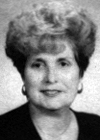Mary F. Wheeler

December 28, 1938 -
Mary Fanett Wheeler was born in 1938 in Cuero, Texas, near San Antonio. John Murphy writes that "When she first went to college she studied pharmacy, but eventually decided to switch to government and had ambitions to become a lawyer. She had always been interested in mathematics and took a course in it 'just for fun'. She ended up with enough courses to graduate in mathematics as well." Mary Wheeler earned a double major in social sciences and mathematics in 1960 at the University of Texas. She received an M.A. from the University of Texas in 1963, and her Ph.D. (1971) from Rice University (when her daughter was 3 years old.) Her Ph.D. thesis was on "A Priori L2 Error Estimates for Galerkin Approximations to Parabolic Partial Differential Equations" [Abstract, Full Version]. She began teaching at Rice University in 1971, rising through the ranks until in 1988 she was appointed as Noah Harding Professor of Computational and Applied Mathematics (first woman to hold such a position at Rice.) Since 1995 she has held the Ernest and Virginia Cockrell Chair in Engineering in the Department of Mathematics at the University of Texas in Austin. She works on numerical solutions of partial differential equations, parallel computation, and modeling flow in porous media. She has written over 200 research papers and technical reports, and authored 7 books.
She told John Murphy:
"My work has always been on the numerical algorithms for solving partial differential equations, and these algorithms apply to a collections of problems like finite-element analysis and finite-different methods. A lot of this analysis has been applied in many of the commercial packages.
I like to gain knowledge, but it is also important to see it applied. My husband was the project leader in designing a pipeline, and I saw how numerical methods played such an important role. These calculations were validated by experiment, but seeing the way that mathematics played a part in design, showed how your work could have a real impact. We have done a lot of work in reservoir engineering and environmental bioremediation, and we have done a lot of work with the Corps of Army Engineers on environmental impact in Chesapeake Bay, Delaware Bay and Florida Bay.
To me it is important to see your work used. I do abstract things as well, and I don't know if I will live to see them applied.
Today, in virtually every aspect of our society, people are using numerical models to develop physical models. But I can remember a period from the 1950s through to the 1980s, when mathematicians didn't feel it necessary to do numeric, or that they should be interested in physical problems - you had to be doing something pure. But if you look back in history, mathematics has always been driven by physical problems. Why not create something that can be used by somebody, rather than have it just sit there in a book to look at?"
Read her profile from the AWM Emmy Noether Lectures.
Read "Using Math to Preserve the Environment" by Julianne Basinger from the Chronicle of Higher Education, February 27, 1998. This article describes Professor Wheeler's career and her current work on creating mathematical models for cleaning up underground contamination.
References
- Murphy, John. "Profile: Mary Wheeler", Scientific Computing World.
- Mary Wheeler's faculty directory page at the University of Texas
- MathSciNet [subscription required]
- Author Profile at zbMath
- Mathematics Genealogy Project
Photo Credit: Photograph used with permission of the Association for Women in Mathematics and is taken from Profiles of Women in Mathematics-The Emmy Noether Lectures, published by the AWM.
